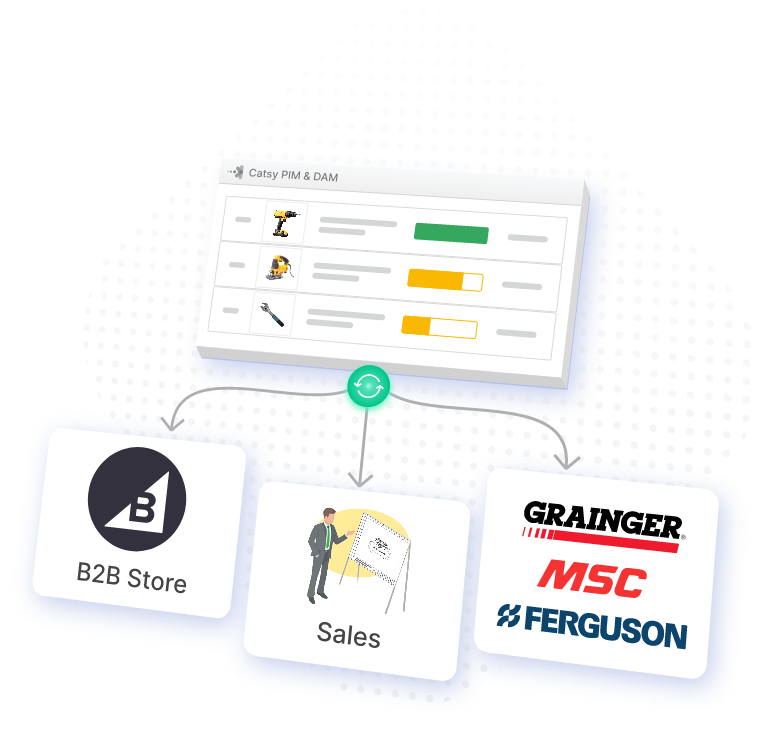Top 10 Reasons PIM can Benefit Your Big Commerce Store

In this Article
Despite its more recent establishment in 2009, BigCommerce has grown into a huge enterprise. Moreover, it promises retailers, small and large, the same exponential success in eCommerce. But with BigCommerce’s complexity, businesses can absolutely benefit from a strong tight-knit union between PIM and their BigCommerce store.
BigCommerce has no limits – not when it comes to stores, products, staff accounts, or file storage. Compared to Shopify, for example, BigCommerce’s accepted numbers are mind-blowing – which makes sense considering so many big brands have migrated onto BigCommerce to tap into online revenue. Brands like SkullCandy, Ben & Jerry’s, Old Spice, and Toyota have set up online store sites.
Why, if they already have plenty of success in retail? Well, in the past few decades, it’s been pretty clear that online shopping is dominating, particularly with modern generations. About 31% of Millenials and less than 10% of Gen Z-ers shop offline, according to consumer research by BigCommerce. Additionally, it adds another channel to the many options BigCommerce offers, like Facebook, Instagram, and Pinterest.
Already operating from the BigCommerce platform? Then you already know what benefits you can reap. BigCommerce has revolutionized the business spheres, promising a yearly growth of up to 28% to users.
If you are operating from the BigCommerce platform, you already know what benefits you can reap. BigCommerce has revolutionized the business spheres, promising a yearly growth of up to 28% to users.
Benefits of selling with BigCommerce
- Includes a variety of tools and features to improve optimization
- Options for themes to improve user experience
- Range of analytics and metrics for quality improvement
- Mobile-friendly, professional themes
- Diverse shipping options, nationally and internationally
To further take advantage of these benefits, and scale your business with a robust ecosystem, a product information management (PIM) system makes this possible.
So here are 10 reasons why BigCommerce and PIM work together seamlessly for all your stores.
1. Eliminate time-draining manual updates
BigCommerce aims to expand businesses with its multifaceted platform. With the ability to set up unlimited storefronts, you can build high brand visibility. With integrations to social channels, you can sell and market on Facebook, Instagram, Pinterest, and so forth. As a result, you have access to a wider pool of potential customers.
On the other hand, the universal fact remains: Managing multiple channels is difficult. Much like juggling, there’s always a risk that one of the balls might drop. You want to avoid spending time or money on a channel that you can even manage.
On top of that, updating product information for marketing is a hassle. Multiple channels and storefronts require better marketing strategies. Brand messaging must consistent and detailed in how it informs prospects about your products. So it all comes down to how you manage that critical information. How you can organize that process can either be a real strain to your business and or maximize its potential.
To put it into perspective, here are just some of the general types of information any ecommerce business needs.
- Product descriptions
- Titles tags, product names
- SKU, cost, attributes
- Categorization labels
- Associated digital assets
Handling these things takes teamwork and time. But the worst thing you can do is top it off with manual processing. Companies cannot expect a swift turnaround time when updating this data into BigCommerce by hand.
Collecting product information manually
To compile all this product information, you must first search for and find each products’ exhaustive data. With everything disorganized, you might find yourself searching through your overflowing files. You might scour through multiple digital assets. So it may take weeks to compile before it’s ready for marketing.
Then, consider the possibility of mistakes in the product information. After all, human error is unavoidable. Once mistakes come to attention, it’s a whole other matter of updating and revising. Thus, this further delays the process of publishing your products.
Overall, this meticulous micromanagement is a waste of valuable time. If there’s anything you want to avoid as a BigCommerce business, it’s wasting time. The world is awash with competing forces. That means speed is one of the major components of a competitive edge.
If you are struggling with slow marketing speed, you are derailing the success of your BigCommerce enterprise. This is where using a BigCommerce PIM will help you efficiently aggregate your product data.
How? PIM targets your marketing process for BigCommerce in 4 steps:
- Centralization
- Automation
- Better focus on what really matters
- Real-time updates and productivity
It starts with centralization
Everything from product information to vivid product images is in one place. You can use PIM as the chief database to store and retrieve all product content before publishing it onto BigCommerce.
With PIM as your principal domain for all product data, your team can access any and all information, without sacrificing accuracy. Any member of your team can leverage PIM to obtain whatever marketing content they need.
Keep it going with PIM automation
Automate as much as possible. Keeping up with Amazon, eBay, social media, your website, and any other channels you’re a part of can quickly get overwhelming. Automation will help things run smoothly without sucking all your time.
Bill Widmer, Ecommerce and Content Consultant (source)
A PIM reduces the risk of human errors usually present when manually updating every single product page. No more worrying about potentially inconsistent information or missing aspects of a product page.
If certain product pages are incomplete and need further attention, you can see it immediately. This tool shifts the energy from time-consuming chores to efficient workflow automation.
Focus on high-quality work
Without rigorous work otherwise required to create content, PIM saves time. By removing the focus from redundant work, PIM optimizes how you go about setting up storefronts. Subsequently, team members can focus on what really matters. Like high-quality marketing.
Real-time updates for productive work
Furthermore, every member on your team (or multiple teams) can view real-time updates on a PIM. The marketing team no longer needs to wait for approval. They can see which products are ready for launch.
Overall, utilizing PIM for BigCommerce results in a streamlined operation.

2. Prevents data errors across stores
Businesses have used traditional methods of storing information for ages. Organizing product data with spreadsheets is a common practice. However, unless you only have one store, Excel, spreadsheets, and multiple files are not going to cut it. In fact, you might be unknowingly countering your business’s success.
With BigCommerce, it’s unrealistic to continue using such inefficient means. Especially not if you hope for increased demand for your products.
Are you still manually updating product information while operating multiple storefronts?
If so, here’s why you’re hindering your own success.
Manual updating leads to inaccuracy
“As organizations accelerate their digital business efforts, poor data quality is a major contributor to a crisis in information trust and business value, negatively impacting financial performance.”
Ted Friedman, Vice President at Gartner (source)
Today, many businesses struggle with poor quality data. New to ecommerce or not, You may have already encountered the pain of manually updating information. Storing your product information in disparate system files puts them at a high risk of error.
Unfortunately, the exertion will only worsen as your company grows.
The truth is, ineffective product management can lead to real, unsavory effects. For example, it may reduce conversions and return-on-investment. Poor data also negatively impacts customer relationships.
Manual updating leads to disorganization
With multiple stores, there are so many products to keep track of. Each product has its own attributes, description, dimensions, and digital assets. And these are just a handful of product information details. Multiply this data several times over, and it will take at least several spreadsheets and files to hold everything. Searching through the files and scrolling through spreadsheets is incredibly laborious.
Once you finally send files to your internal teams, they then have to extract the specific files they need. Each user could download the files to economize their work. However, that means disaster in the long-run. What if you need to make updates to the master files? There’s always the chance that not all employees will manage to redownload the files.
Without a centralized system, you may struggle with a mixture of updated and outdated information that now exists across platforms. Furthermore, lacking a workflow software disconnects team members – leading to miscommunication and disorganization.
Increased risk of customer distrust
The internet is open for anyone to do their own research – and people do. About 87% of customers start their product searches online. When it comes to more expensive products, at least one-fourth of customers do intensive research. Customers take product research seriously. Regardless of whether shopping is online or in real life, customers do as much research as possible before making a buying decision.
What does this mean? First of all, customers will know immediately if your information is inaccurate. Especially after learning about it elsewhere.
It also means that any accidental errors will not be easily forgiven. Customers might have a different impression of the product they receive than what they expected.
Inevitably, you will get many returns. But, more importantly, customers may no longer trust your brand. Even if they do buy your product, they’ll return it once they realize the actual product conflicts with the product page. Consequently, the customer will post bad reviews or spread their negative experience by word-of-mouth. Reputation goes downhill from there.
In other words, inaccurate product pages lead to customer dissatisfaction.
So you must up the ante on your product information. Your goal: educate prospects as much as possible. First of all, you’re competing with these other platforms that shoppers use for research. People will simply trust honest sellers who provide all details. If you’ve answered all their questions, you know what you’re doing.
When it comes to errors out of your control, you can prevent them by automating the data management process, with PIM.
Time-consuming tasks
On top of all the other negative impacts, the biggest struggle is combing through files.
If you’re still trying to manage a BigCommerce enterprise manually, you’re probably keeping hold of numerous files. To organize everything, you need at least several different files. For example, there may be files per store, per category, per product, and even per digital asset.
Imagine how much time it takes just to search for individual items to compile. All that time could have been better used doing more productive things.
Instead, productivity is slashed. Organizing and gathering of information is the most time-intensive process. For this reason, it steals time away from other teams to do their own jobs. They can’t work until they receive the compiled information. Overall, managing many files obstructs a smooth workflow.
Slower time-to-market
Everything in the business process is connected.
Inefficient data updating slows down all other tasks, including the marketing teams’ campaigns. The retailers who require your product updates also have to wait, hampering the actual business. As a result, you now have a reduced competitive value relative to other companies.
Time-consuming tasks
On top of all the other negative impacts, the biggest struggle is combing through files.
If you’re still trying to manage a BigCommerce enterprise manually, you’re probably keeping hold of numerous files. To organize everything, you need at least several different files. For example, there may be files per store, per category, per product, and even per digital asset.
Imagine how much time it takes just to search for individual items to compile. All that time could have been better used doing more productive things.
Instead, productivity is slashed. Organizing and gathering of information is the most time-intensive process. For this reason, it steals time away from other teams to do their own jobs. They can’t work until they receive the compiled information. Overall, managing many files obstructs a smooth workflow.
Slower time-to-market
Everything in the business process is connected.
Inefficient data updating slows down all other tasks, including the marketing teams’ campaigns. The retailers who require your product updates also have to wait, hampering the actual business. As a result, you now have a reduced competitive value relative to other companies.
In other words, during the time that you’re organizing data, your competitors have already taken the chance to one-up you. They get better search engine rankings and first-serve customers looking for their products.

With PIM, BigCommerce data updates are easy
With a PIM, there is no longer a need for spreadsheets or any cutting-and-pasting.
All information is available on the software and can be updated in real-time. Your employees no longer need to recurrently download updated master files. Additionally, you can discard out-of-date data easily.
By using PIM, the percentage of staff spending less than 2 hours a week looking for products can jump from 17% to 36%. PIM practically doubles overall efficiency.
Moreover, you can automatically populate your data on all platforms with Catsy’s PIM. When everything is up to date, all your teams can get on their work faster, without error. Invest valuable time into more important things, like creating enriched, highly informative product pages.
PIM prevents inconsistency
Because of the single truth that PIM provides, you don’t have to worry about inconsistency. On PIM, the same product information is automatically pushed onto all BigCommerce platforms. Everything is optimized and linked to digital assets. It’s a huge improvement from having to manually extract various information and images from separate folders.
Overall, PIM provides time-saving processes to manage all BigCommerce data. Not a single store-front is missing out on quality. All employees have up-to-date information, thus limiting confusion and disorganization.
Because of this, product pages can engage customers. Also, your brand remains harmonious no matter the platform. Using an automatic data management tool refines productivity all around.
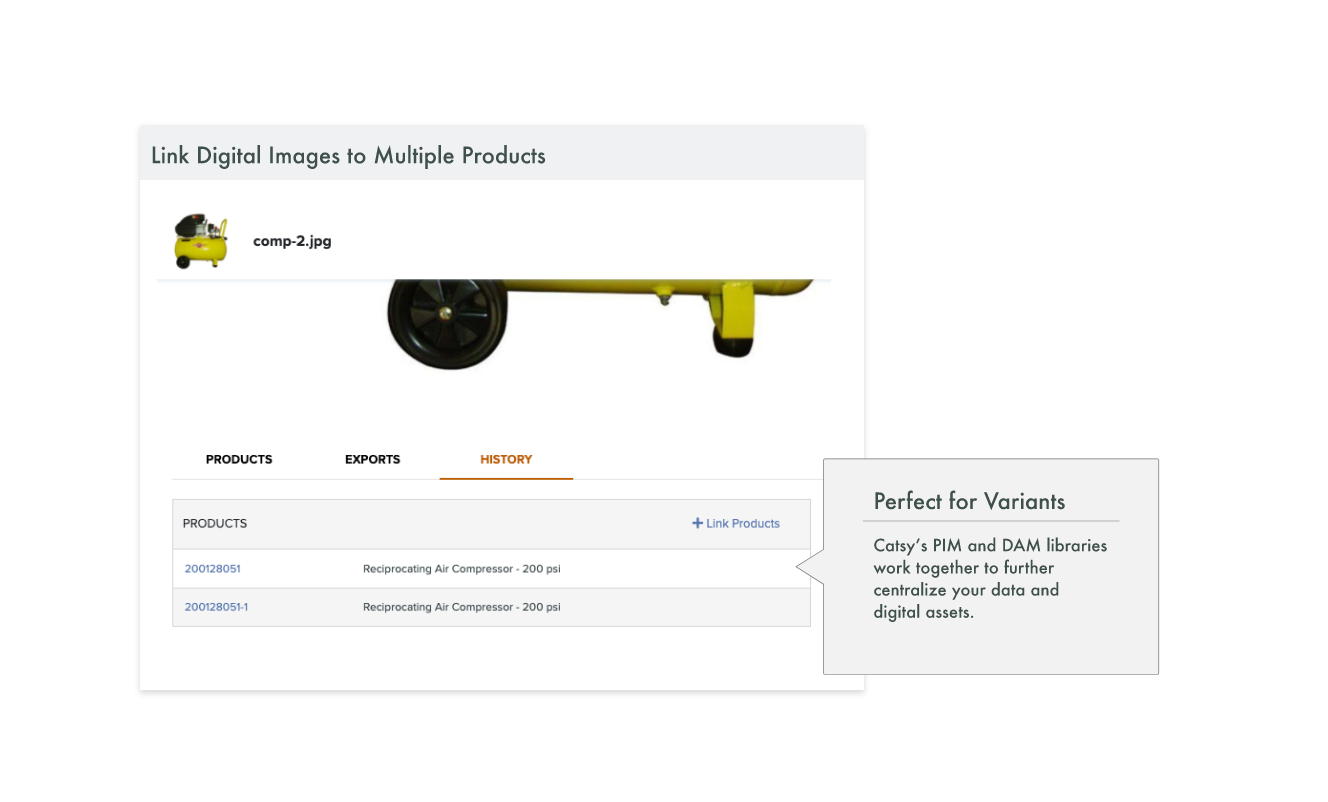
3. Links product images and attributes
Each storefront needs a unique experience. On a practical level, it’s important to make each one relevant to the buyer persona. At the same time, organizations want to reuse their digital assets to simplify the process.
Employing digital asset management software (DAM) may help. But ultimately, they fall short in consolidating your business processes. For example, many standalone DAM systems fail to join images and product attributes. Additionally, there’s a wide variety of media types to manage.
Types of Digital Assets:
- Multidimensional images
- Thumbnails
- Videos
- 360 spin images
- Audio files
- PDF files
- Barcode creation
Today, more companies are jumping onto the customer experience bandwagon. About 86% of customers say that they would pay more for a better customer experience.
As such, software like PXM is increasingly growing in use. A Product Experience Management (PXM) software combines product info and digital assets. Essentially, PXM is really just a PIM that includes DAM. Software like this helps enrich product pages, providing a better experience.
Why link digital assets with product data on a PXM/PIM?
- Strong, compelling content
- Enriching product pages that convert
- Easy to convert raw data into customer-friendly information
- Images attached to products simplify syndicating to retailers
- Brand awareness & reduction in returns
Are your product information and digital assets separate?
If so, you might have felt the inconvenience of this process. DAM software can help organize the many multimedia files you have. But there’s a drawback. Keeping the digital assets apart from the product attributes quite ineffective.
Here’s why.
With BigCommerce, each store has many different products. For each product, you need several images. Such as a primary image, several alternate images, spec sheets, videos, 360 spins, and PDF files.
Once you send out all the files, it is a tremendous workload for your teams. They must match up the product page descriptions with the product’s digital assets.
Finally, you upload the images and push them onto each platform. Now, you manually add in all the optimization attributes – for each site. That adds up to a lot of image alt tags and metadata per site. You can blow past this problem if you have only one or two eCommerce platforms. If you want to continue to grow your enterprise, the process will become increasingly complex.
Having a central place to store all product information is incredibly useful. However, separating product information from digital assets is counterintuitive. With BigCommerce, PIM software lessens the load of juggling many product pages.
PIM combines product information management with digital asset management (DAM) for an even more optimized process. Digital asset management collects all multimedia files connected to your products. This simplifies the process of searching for and retrieving a digital asset.
With both product data and digital assets linked, you never have to feel scattered when looking for files.
Linked digital assets improve optimization
Customers always buy with their eyes first!
Alexei Alankin, Founder and CEO, Eventige (source)
Ecommerce products remain inaccessible to customers physically. Therefore, more sensory experience is needed for increasing conversions.
Digital assets are the more visual aspects of a product page, including anything from images to videos, audio files to graphics. Without digital assets, product pages are left bare and unsavory for customer experience.
Today, more search engines use visual search. With that, 35% of Millenials and even 30% of Gen X population want to search for products by image. Without detailed, quality images, you could be missing out on a huge customer base.
Customers want to see and engage with products. Detailed, high-resolution images with a 360-degree view or an informative video can help do so. An engaging experience is crucial in increasing conversions.
Storing digital assets with product information on a PIM improves quality.
Ascribing products with their digital assets is the key to efficiency. When syndicating files across different channels, images remain connected to the product information on every platform. Essentially, PIM and BigCommerce maintain consistency.
The main advantage of this is that you can jump into your Search Engine Optimization (SEO) strategy right away. Unifying your BigCommerce store’s digital assets onto a PIM is a perfect entryway into attaching relevant keywords to your product pages. When stored in a DAM system, assets are described by metadata. To clarify, metadata gives information about what the asset is, who owns it, and where it’s located. Integrating keywords into the metadata of a data asset increases your chances of attracting leads and improving conversions.
Previously, you may have had a tone of similar files. Now, for each product, you only need one version of the assets. For example, instead of a file of all the icons, banners, logos, and different views of a product, a PIM organizes the media by type and any other dimensions. It disentangles the issues of searching for a specific asset.
A PIM combined with a DAM unifies the alliance of product information and visual aspects. In other words, you have all of your product media in one place, linked to the respective products.
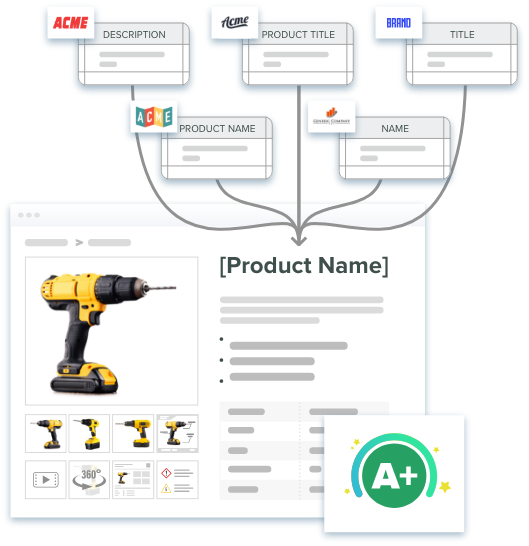
4. PIM optimizes product names for BigCommerce
“Search marketing is the most effective source of acquiring new customers in 2014 – and that means site optimization is top priority.”
Jim Yu, the CEO of BrightEdge
When you have multiple BigCommerce storefronts, there are a plethora of products across different marketplaces like Amazon. Usually, juggling all of these channels can mean you are able to target a larger spectrum of possible customers. Your products now have multiple entry points for customers to search, find, and eventually buy your products.
However, it also means you have several different channels on which to optimize for search engines.
Search Engine Optimization is necessary to draw customers in. With the right, specific, customer-oriented keywords spattered through product pages, you can increase site traffic.
How do you implement your SEO strategy across all marketplace channels? Utilizing a general SEO strategy is the least optimal thing you could do. General keywords will not work the same across all channels because different demographics of people are more likely to frequent some websites more than others. Doing so will counteract your multi-storefront BigCommerce goals. Having all of these channels is supposed to increase leads, conversions, and chances to improve ranking on search engines.
A general SEO strategy doesn’t work.
Instead, you need to implement a persona-specific strategy. Establishing customer personas is necessary. With many marketplaces, you need to attach a specific demographic to each one. This way, it increases that target persona’s likelihood of stumbling on your products.
How do you manage and individualize each platform’s optimization? All while staying consistent with each persona’s brand?
“Be consistent. Once you’ve hit on a brand message that you think resonates with your target segment, use every communication channel you have, to reinforce and amplify that message.“
Jason Dea, Director of Product Management, Telus Health (source)
However, it can be challenging to tailor every single store to a persona. To do so, you need several rounds of persona-specific keyword research, along with manually editing multiple product pages.
Maybe managing only a few products isn’t too daunting. After adding more products, though, managing your optimizations can become overwhelming. Understandably, everyone wants their BigCommerce business to grow. But the more products you add to your reservoir, the more work you need to invest to optimize each product page.
Alternatively, your SEO strategy might be too inefficient for expected business growth. Much like multitasking, dividing your attention between multiple stores sacrifices SEO quality.
Difficult to Stay Consistent with Personas
So not only must you adjust each store for a persona, but you also have to keep track of all keywords. The process will be long and enduring. If you do manage to do it, how can you stay consistent with each persona?
When you’re supposed to manually tweak the channel to match the buyer persona, it is challenging to stay true to several brand images. There are many elements to optimize: names, product keywords, image tags, alt text, and so on.
Optimizing product descriptions, names, and other on-page elements aren’t just about keywords. It also involves portraying a persona-specific that remains constant on the respective channel. Persona-driven pages needed highly specific product tags that are included in as many elements as possible. Doing so on BigCommerce without a PIM is incredibly demanding. Mistakes can be hard to avoid.
More importantly, customers pick up on this lack of continuity. Brand consistency is key in maintaining customer relationships. Without it damages the potential rate of conversions. Even if you have great SEO, lacking brand consistency won’t get you the ranking you need to drive leads.
Optimizing for BigCommerce success starts on PIM.
PIM has all the components you need for SEO:
- Keywords
- Product tags
- Image metadata
- Mobile compatibility
- Digital asset functionality
- Tailored brand message
Every individualized SEO strategy remains organized in one place. A PIM allows for persona-specific keywords to populate across respective product pages. This creates a uniform, constant brand relatable to the buyer persona. Consequently, people who make up the persona demographics are more likely to find your products. Being able to relate to all facets of the brand will engage their interest much longer. Finally, by encouraging stable customer trust, a PIM contributes to more conversions.
Implement SEO on PIM before a BigCommerce marketing launch.
A great strategy does not just stop at keywords.
With a PIM, you can automate the process of integrating keywords into on-page and off-page content. Product tags, for example, can directly translate into SEO keywords with the help of a PIM. Narrow down product tags as much as desired to allow customers to locate your products. A PIM automatically spreads out product tags throughout every possible location on the product page. The title tags, image alt tags, meta tags, and other technical page elements are also effortlessly optimizable.
With these PIM aspects, you can deeply tap into the potential of a multi-storefront BigCommerce operation. Rankings on search engines improve across all product channels. More importantly, you can stay organized.
When it comes to SEO, the search engine landscape is not static. Rather, the things people search frequently change. Any SEO strategy, no matter how general or specific, must remain dynamic. Keeping up with SEO trends necessitates a lot of updating and revising of keywords and page optimization.
Without a PIM, the initial SEO implementation with BigCommerce is already challenging. Imagine doing so manually every time you need to update information. What if the SEO strategy didn’t achieve the expected results?
A PIM software simplifies updating.
Easily observe the analytic reporting available on a PIM. It is continually detecting any gaps in the content. Usually, you would have to traverse this yourself; always double-checking to see what you’re missing in your optimization. With a detailed view of all your product pages, a PIM improves product content enhancement on BigCommerce.
All these factors culminate in streamlined customer experience. With ample product information, content preserves quality and relevance on all channels. Customers are more likely to find and trust by your brand, with the all-encompassing optimization.
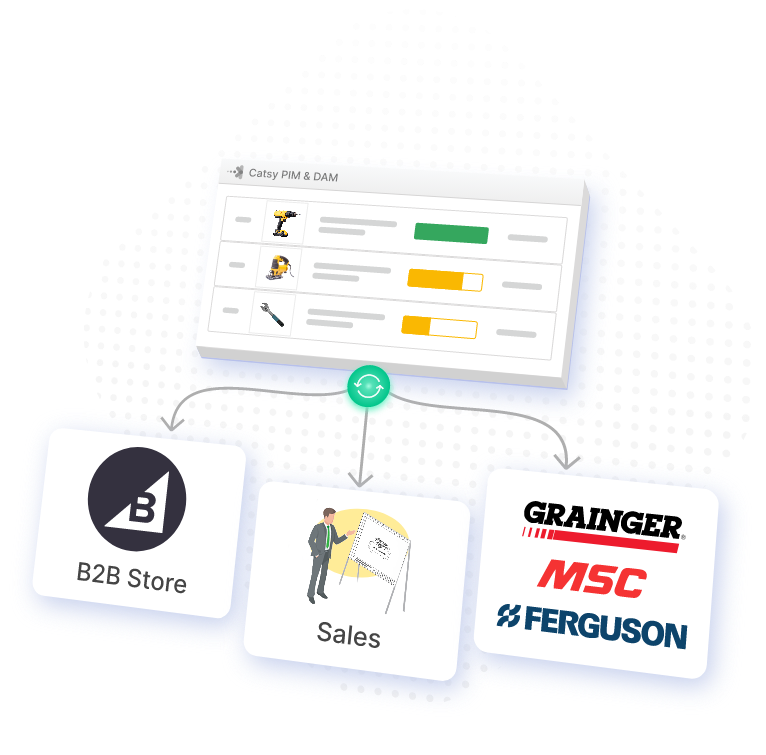
5. Simplifies scaling across multiple stores
It all starts with data management. It’s the foundation for a successful omnichannel approach.
Eamon Rodeck, Founder, Weizen Young
If you have a team, it is hard to coordinate, especially with multiple stores. A PIM allows BigCommerce stores the digital foundation to operate at scale.
When it comes to operating stores on BigCommerce, scalability is an important factor to consider. BigCommerce is fit for scalability, as it allows businesses opportunities for expansion on a global level. The more stores you have, the higher the likelihood that the target consumer finds it when searching.
However, BigCommerce scalability means that have a system in place to keep up with potential growth. Additionally, it means being prepared to dial back if expected growth does not occur. In other words, scalability goes both ways. Therefore, it’s more cost-effective in the long run to be ready to support all storefronts, regardless of the volume.
If you want to expand your multiple store business, you might come across many pitfalls.
Having an effortless scalable process isn’t so simple.
A lot of troubles come with trying to address demand levels without an organized process. If you run into accelerated growth, which is an incredible sign of success, you can’t meet the demands without preparation. You now have to expand in ways that may be more than your team can manage, like adding a lot more products or attempting to push a product through a new platform. Numerous updates are necessary on all accounts.
When it comes to global expansion, it’s an even bigger feat to accomplish.
With multiple channels, it’s difficult enough to manage the workflow, the volume of products, the connections with third-party suppliers, and the syndication to a variety of retail platforms. You might have to spend more costs than otherwise necessary for increasing staff. Translating product pages into multiple languages is critical.
The other side of having flexible scalability is overestimating growth. If you are inaccurate in your expectations, you may have spent more time, money, and resources than needed.
Disorganization slows time to market.
Not only is scalability challenging without a proper process in place, but it also affects market speed. It may seem ironic that what could potentially grow your enterprise might be its downfall.
Growth is a double-edged sword.
Inefficient scalability will mean that your growth may stall. At least until you finally get your plan into action.
The delay could mean falling behind on trends and slowing down the launch of new products. The quality of product pages is significant, but a slow time to market will affect progress regardless. During this time of setting up, competitors have the chance to one-up your business, dominating the market before your new products or channels are even established.
Losing out on trends is also a major risk of inefficient scalability. By the time your products are out, people will have already moved on to the next thing.
Without a smooth process, there’s a high risk of error.
Keeping track of so many product channels is quite demanding. Doing so without a central location which holds all the truth your business needs will be time-intensive. It’s incredibly costly to manage so many channels, even more so to add new channels.
Disorganized attempts to scale your business may result in reduced quality. Much like managing product information and data on spreadsheets, you will be at high risk of making errors. Even the smallest mistake, whether it is a misrepresentation of a product or getting keywords mixed up, could make a grave impact on sales.
Gen Z population are more likely to return 75% of online products
Most of the returns customers make are due to inaccurate or suboptimal product descriptions. About 22% of product returns are due to not meeting expectations. If someone orders a product and finds it incongruent with the information on the product page, naturally they will return the product. It’s all the more crucial to establish brand integrity from the beginning.
Consider that any tiny mistake could cut down on revenue and damage the persona brand. Thus, this adds more wasted costs and time fixing the problem.
Without PIM, BigCommerce team coordination is difficult.
If you don’t have a smooth workflow in place, you may struggle with coordination with employees. Managing a BigCommerce operation requires much collaboration within internal teams and with external sources.
The goal of BigCommerce is to expand.
That means electing various teams for specific roles, working with teams in other regions, connecting with retail platforms, warehouses, and other third party logistics. When it comes to global expansion, it also means having multiple translations for product pages to allow for localization.
Without good coordination, efforts to grow business at an international scale will end poorly.
With inaccurately translated product pages, you may alienate people globally. Mistakes in optimization may occur depending on the channel.
Using spreadsheets to manage all of this is not conducive for scalability. Manually updating such files won’t keep up with BigCommerce growth demands. It further dampens the amount of work required to manually compose accurate, detailed, rich product descriptions.
PIM for BigCommerce for automated scalability
A PIM like Catsy is the ideal tool for operating your BigCommerce at scale.
Using a PIM allows for a central software that connects all the sources and platforms you need. You can collaborate with ERP systems, suppliers, warehouse systems, as well as hold all your platforms on which you sell your products.
Adding more platforms is easy and cost-effective. Automizing for scalability is embedded in the software. It automatically manages the rate of exports and organizes multiple channels. You can then focus on product page enrichment – making high-quality product descriptions and enhancing digital assets. Editing product information need only be done once, and all the information is pushed onto appropriate platforms.
Collaboration on PIM is key for global growth.
With the ease of product additions and data enrichment comes also the ease of collaboration. The workflow component of a PIM makes it easy to coordinate teams. This means you can allocate teams to translate product information. By including multiple language translations, your stores become accessible worldwide.
All team members have access to the truth compiled on a PIM. As a result, every team stays up to date with internal processes and updates. You don’t have to continually upgrade staff just to keep up with the demands of scalability. Team members can easily see, access, and perform their tasks.
The seamless process of a PIM improves the speed and quality of BigCommerce operations. PIM encourages BigCommerce growth with a variety of integration tools. Overall, this culminates in smooth expansion, high productivity, and faster progress.

6. Maintains sensitive information like pricing
Have you ever experienced any security breaches in your business process? Ever had incidents where pricing information fell into someone else’s hands? Understandably, it’s troubling to have sensitive information available for any eye to see. If these things have occurred to you, you probably have yet to establish role-based access.
Role-based access is necessary for BigCommerce.
Role-based access control (RBAC) gives the administrator the power to ascribe various roles to employees. As the admin, you have the ability to restrict access to certain information.
If you manage many team members or internal employees, which is given in BigCommerce, you may be risking business data safety. Some of your workers may be remote, so you have no idea how much you can trust everyone. When all employees have access to view and edit any information, you are opening the doors to data leaks. There is no security that everyone will comply with confidentiality and privacy requirements.
Furthermore, unregulated access to all tasks on a workflow, for example, can lead to mistakes. Some employees may edit something outside of their responsibility, resulting in inaccurate information. There’s no accountability. Who knows who updated certain information or edited a task?
Unrestricted network access is inefficient.
What about the hiring process for a new employee? Having to always manage paperwork and network authorization manually wastes time. It’s demanding to hire a new member or change a person’s role.
Sometimes, it’s necessary to integrate third-party contractors or retailers on your information management system. Consequently, it’s difficult to moderate their access to the enterprise’s personal data.
Catsy PIM incorporates role-based access control.
Using a PIM that includes RBAC can eliminate any security breaches or inefficiency in the workflow. The administrator can manage access rights based on the employee’s job position. Access depends on an employee’s job responsibilities. By making it clear which tasks are accessible by whom, the workflow is streamlined. Employees need only focus on the tasks and information open to them. In addition, the administrator can easily oversee processes.
With a PIM, you have complete security that users and guests are restricted only to what is necessary. The result is improved productivity overall while preventing possible unauthorized edits or leakage of data. There is no longer a need for cumbersome paperwork when hiring new employees or adding external sources. Simply assign them a role on the PIM that tailors their accessibility.
Role-based access travels to all systems. Therefore, you don’t need to manually edit every employee’s role over again in other applications.

7. Includes audit history with APIs
Centralizing one area as a one-stop-shop for all your BigCommerce product data needs is time-saving and improves success. However, it doesn’t stop there. Imagine compiling a ton of product information onto one place without tracking the changes made.
Lacking an API complicates auditing and infrastructure.
More traditional or manual updates to product information, although sufficient tools, might be causing more trouble than you think. Unlike Catsy’s PIM, many of these tools lack an API, an application programming interface. The great thing about an API is its ability to smoothly connect different application within your system. That means connecting inventory storage and order history, for example.
With an API-augmented PIM, you’re missing out on some seamless integration of all your applications. If you don’t use an API, you might be incorporating a point-to-point integration instead. The thing about point-to-point is that it can work if you don’t have many components to your enterprise. However, with BigCommerce, it is incredibly unrealistic.
Traditional integration methods aren’t for BigCommerce.
Depending on point-to-point integration for multiple storefronts is damaging. It’s costly, can easily grow more complex, and just isn’t fit for scale. Refraining from using an API could be hindering your business growth and success.
Here’s why: If you aren’t using an API, that means all of your systems – product information management, workflow, data, orders, inventory, retailers – are separate, with a thin vein of connection between them. Every time you want to connect two systems, a new, customized code is necessary.
Over time, these multiple codes interconnected between systems become complex. The problem becomes in your infrastructure – one small issue, and all the systems shut down.
As an enterprise grows, you will need to increase resources for your team of developers, or hire more developers. After a certain point, it becomes impossible to manage and document all the point-to-point integrations. Continuing without an API in place is not reliable, and it could mean costly infrastructure issues down the line.
Difficult to sync or observe updates.
Audit history chronologically records every single thing on a PIM. This includes adding new data or information, updating previous information, or deleting information. It’s also continually evaluating the state of the product information management – whether all processes are effective or if any product page elements are missing or incorrect.
history chronologically records every single thing on a PIM. This includes adding new data or information, updating previous information, or deleting information. It’s also continually evaluating the state of the product information management – whether all processes are effective or if any product page elements are missing or incorrect.
With an audit history, you are forced to remain alert and attentive to all the changes. The likelihood of missing something or overlooking an error is quite high. If you are managing a BigCommerce operation, you understand how much effort goes into micromanaging each component. You need to be able to see all the activities going on.
Risks of lacking API-augmented audit history:
- Sacrificing content accuracy
- Vulnerability to security breaches
- Slower System Recovery following a crash
Sacrificing content accuracy
PIM audit history logs analyze the completeness of product information. Usually, it’s hard to keep track of all the data on your own. For every product page, there are several components: product specifications, attributes (like price and SKU), main data (titles and descriptions), supplier data, media, and so on. A workflow may be conducive to productivity. However, without a viewable history of which users completed what tasks, you might be unwittingly losing out on quality content.
Attempting to manually take account of all actions is not possible. Inevitably, the risk of human error increases. Consequently, error leads to inaccurate product data, which is a massive obstruction to revenue and conversions.
Vulnerability to security breaches
It’s critical to know the changes made and by whom, for example, tracking a person’s decision to such a product. Without an audit log in place, you risk security breaches of private company information. An audit can show you all potential intrusions based on all the actions leading up to the security breach. A PIM that lacks an audit tracking feature opens the doors to information misuse, unauthorized changes to vital product details, and even fraud.
“Damage can be more easily assessed by reviewing audit trails of system activity to pinpoint how, when, and why normal operations ceased.”
The National Institute of Standards and Technology
Slower system recovery following a crash
A system failure of over an hour cost $300,000 for about 81% of businesses.
When your BigCommerce system or main software crashes, how do you figure out the source? It’s nearly impossible without retracing the steps of all processes.
Recovering the system may take a lot longer than necessary, wasting time you could be using focusing on your enterprise. Employees’ work gets delayed, and any IT specialists on board may have to work overtime to get everything running again. Furthermore, any information or data loss might be gone forever.
PIM allows for troubleshooting.
With an integrated audit history system, there’s no need to worry about losing product information. Every piece of data tracked by the audit can be reconstructed if lost or damaged. By assessing all the steps and changes made, you can recreate lost files by backtracking.
Even system crashes won’t be too much of a hurdle. In any intensive software, system crashes or damages are inevitable. It’s how you manage the recovery process that can get your software and your BigCommerce business up and running again.
With audit history logging, the events leading up to the system crashed can be assessed for quality improvement. Analyzing the contextual data can help prevent potential system crashes. The same process applies to possible data corruption or security breaches.
Catsy PIM includes audit logs and precise tracking tools within the software. Such tools let you be sure everything is completed. You keep track of any missing attributes. All changes are transparent, in order to ensure that users are only doing authorized actions outlined by the role-based control feature. By incorporating security at the attribute level, meaning every single product detail is accounted for, Catsy helps strengthen compelling content.
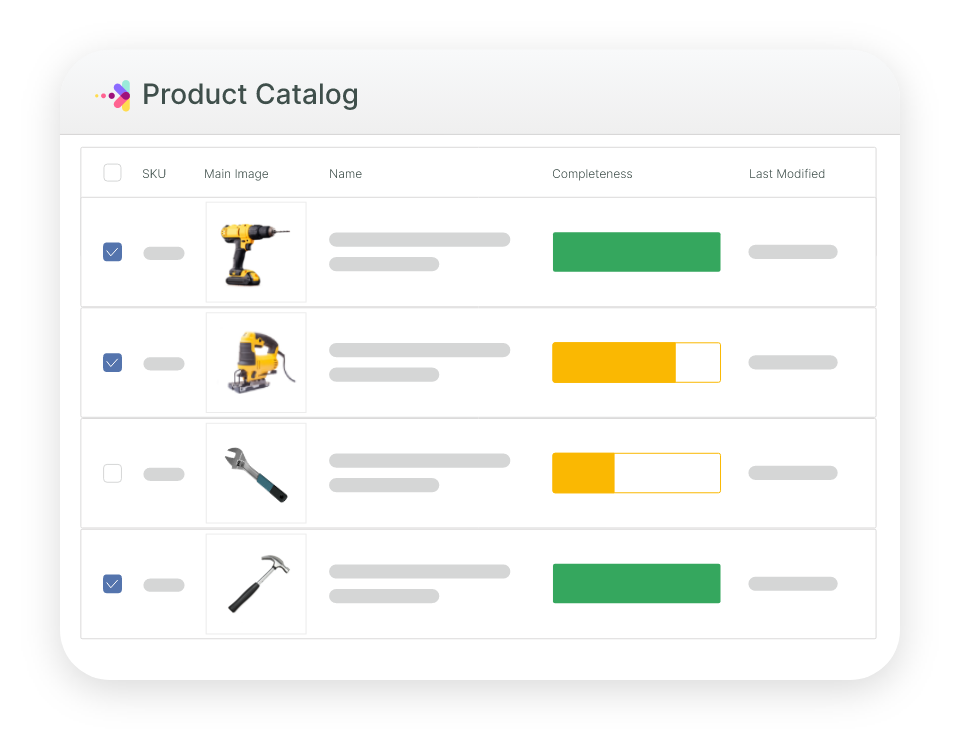
8. Integrates sales & customer-service catalogs
“A satisfied customer is the best business strategy of all.”
Michael LeBoeuf, Business Author
In any business, you need collaboration between different teams: marketing, sales, customer service. The same holds true in the digital lanscape. When a product is published, the various specifications, dimensions, and images have to be consistent across the entire enterprise to serve customers well.
Organizations that have fragmentation in this strategy go through a few challenges.
The Top 4 Challenges to Team Collaboration:
- Inconsistent content across channels delays conversions
- Inaccurate data leads to more returns
- Poor customer service lowers customer satisfaction
- Incongruent brand image reduces repeat business
A PIM solves these challenges for BigCommerce. Because the same central hub that serves product managers and the marketing team to manage content also serves sales and customer service. All teams can connect to pull the latest content.
Product information isn’t only valuable for stores. Sales and customer service also need product data to serve and convert customers. A PIM creates a digital hub of product information and digital assets for Bigcommerce and other channels. It’s for all departments in the organization. The information is at your teams’ fingertips.
Without a PIM, it’s difficult for teams to collaborate.
Top Benefits for Inside and Field Sales
Often, a sales representative needs to develop a plan tailored to customers. In order to better engage the target, the sales team needs certain product information in order to successfully sell the products.
Use cases consist of the following:
- Who? Description of the target persona or brand, customers segments
- What? Selecting the products the customer is interested in
- Why? The main reason or desire of the customer
- When? During what stage of the sale funnel is the customer and how to adjust pricing.
- Where? The method of sales delivery, and hence the logistics content they need to successfully close business.
How can the sales team obtain the information used to formulate a use case?
For the BigCommerce sales team to maximize their work to bring in revenue, they need access to the PIM.
To drive revenue and growth, sales reps also need access to digital catalogs. This could be to generate price books or price guides, or any sort of master product catalog. Price books are necessary for the sales team to be aware of standard pricing for all products. In BigCommerce, you may need a ton of price books. Especially if you have a lot of products.
A PIM like Catsy makes it easy to market products for customers. Whether they go on to finish the purchase either on your BigCommerce store or in-store, PIM is conducive. But this process typically starts with a catalog. Catsy includes built-in support for your sales team with the same content that is on the BigCommerce store.
Top Benefits for Key Accounts
Key account managers connect the customers and the business. In particular, they focus on the long-term connection with valuable customers. Usually, this occurs in B2B marketing. In this way, key accounts management diverts from sales reps in how they cultivate a relationship with a key customer. The relationship doesn’t end at the transaction. Rather, key account managers continue to build loyalty and form a partnership with the customers.
As a result, the sales cycles in key accounts tend to be a bit drawn out. Hence, it might require different layers of content in different stages of the sale.
Benefits of PIM for Key Accounts:
- Initially, the key account rep may have to share a digital catalog of products.
- Later, they share thumbnails of products, along with pricing and forecasting information.
- Additional information includes logistics and shipping information, like dimensions and specifications.
- Finally, marketing content and product images.
A PIM allows key account reps to generate all this necessary information. It optimizes the process of creating a digital catalog and sharing this content with the key accounts. All of this can be done from the same central hub that is populated by product managers, specialists, and marketing teams. Content remains consistent, so you don’t have to worry about inaccuracy or errors that could jeopardize any workflow.
Top Benefits for Customer Service Reps
When selling to customers or to businesses, something that everyone strives for is to land a repeat customer. What better way to do that than amaze customers with a unified brand experience? Unfortunately, doing so can be challenging if different teams are presenting a different image. Your primary brand image is a certain thing, but due to a lack of consistent truth available to all teams, your customer service reps may be portraying a completely dissonant image.
More companies today are integrating their customer service teams into the workflow. At least 55% of companies have done so, to further optimize their customer relationships. There needs to be a centralized platform that easily brings all teams together, including the customer service reps.
When customer service teams have access to the same PIM, the team and customers win big.
With PIM, customer service reps can:
- Answer questions quickly
- Share all the specs and dimensions
- Lookup related product parts and accessories
- Distribute vital digital assets like installation guides and spec sheets easily
- Provide troubleshooting information
All of this makes it easy for a business to retain customers who can clearly see consistency across product information, brand, and values, thus improving the overall trajectory of growth. A business is nothing without customers, and keeping them is just as important to attracting new customers.
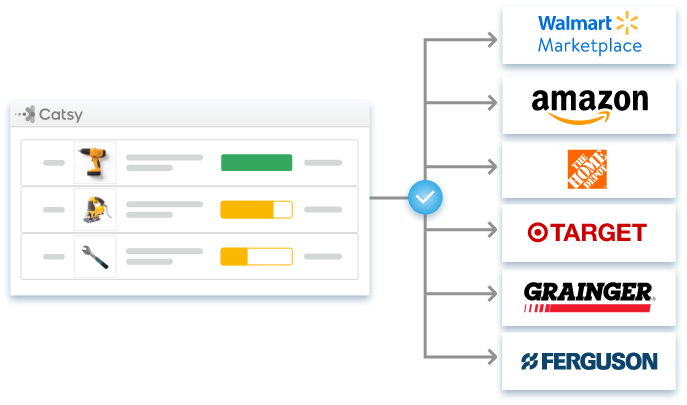
9. List products on 3rd-party marketplaces
Selling on marketplaces can get incredibly involved, even for the most experienced sellers. With endless steps and validation rules to overcome, it can take a process before you can begin listing products. Even once you get to the actual listing process, you are required to fill in listing names, bullet points, descriptions, images, a wide range of other attributes, and even tax information. All of this is necessary for not only enriched product pages but also accurate information for the platform to process your business dealings.
After that, the job’s not over yet.
Once products are listed, there is also a need to optimize the listings. With SEO, there are optimization opportunities dispersed everywhere – and you need to take advantage of all of it as much as you can. Otherwise, it will be difficult for customers to find your products. Essentially, all the work you put into organizing and distributing products to retailers is nothing without fantastic optimization.
In addition, there may be questions that may need answering to improve conversions. Always include a Frequently Asked Questions section on your product pages. It’s better to answer customers’ potential questions better they ask. This way, the time for customers to travel through the sales funnel to “buying decision” can be quicker by providing answers to any of their contemplations.
Once products are listed, it takes effort to update images and other content for the listings to post with all the content you would like to see next to the product. Attribute requirements like length and quality of the descriptions can be anywhere from pleasant to fix to downright nightmarish.
For example, here are just a few of Amazon’s requirements:
- Product titles must not exceed 200 characters, including spaces
- All products must be accurately categorized
- Product variants have to be uploaded in a certain format
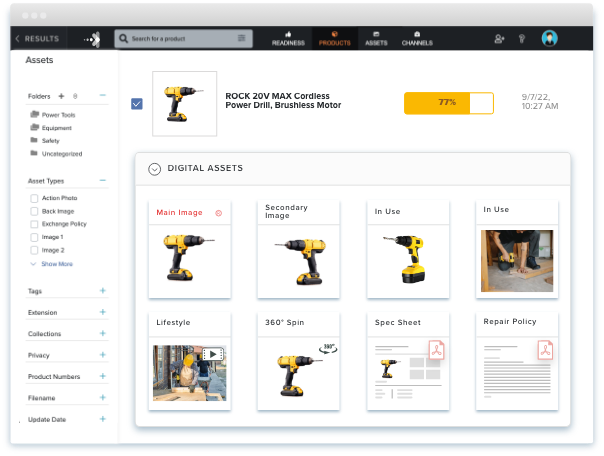
Once the fixes are made, these descriptions have to be saved, rather than lost. Consequently, this is where auditing functions come into play.
With a PIM, BigCommerce’s large task of compiling data becomes simpler. Additionally, it’s easier to comply with various marketplace requirements. For example, the PIM will flag if the character lengths are not in accordance with each sales channel. Some advanced PIMs will also grade the content and descriptions automatically. That way, you are hitting the acceptable criteria while optimizing your content.
With a PIM, the process of collecting and sharing these attributes is simplified, automated. The same content you are sending to BigCommerce, PIM distributes to other sales channels, retailers, and marketplaces.
Ultimately, the advantage of a PIM is as such: Instead of getting bogged down by these nuances, you can instead spend your resources on marketing your products. You can instead focus on creating content or sourcing more images for your products. Actions that actually impact conversions can be the center of attention.
Image requirements are more complex.
We already know that managing product attributes is demanding as a 3rd party seller. But what about the images? When it comes to image requirements for listing products on marketplaces, it’s an entirely different game.
For marketplaces, images must have a pure white background – a point-blank RGB value of (255,255,255). There is no messing around with backgrounds, especially for the main image. Customers need to see the product in white space for better contrast and visual detail.
As for size, the images should be 1000 pixels or larger in either height or width, in order to enable the zoom functionality. Zoom capability is such an important aspect of customer experience. People want to see every detail, dimension, and texture before making a buying decision.

Every marketplace or sales channel has different image requirements.
Another hurdle is trying to tailor each image to the requirements of the sales channels you’re selling on. You can bypass this issue with a PIM that includes a DAM. Other than improving file organization, the purpose of the DAM is to make the task of transforming images a smooth one. That means converting all images to comply with each channel.
This compliance varies from marketplace to marketplace. It could be different from how you want your images on your main BigCommerce store. In some cases, the image file name needs to be replaced, or the images have to be delivered as URLs. In other cases, an image has to have an extension that matches the product SKU number. Needless to say, it can be had to tailor endless amounts of images to each marketplace’s requirements.
PIM with BigCommerce makes images transferable.
No matter the case, PIM supports BigCommerce by tailoring images to the marketplace. On top of that, a PIM like Catsy also works itself back into the workflow around the image. For example, let’s take an image that is specifically taken for a marketplace. This image may be the same image you put on your BigCommerce site or a different sales channel. This orchestration of the image goes back into the workflow for photography, which can be achieved with a PIM & DAM solution.
Ultimately, selling your products on direct to consumer (D2C) site like BigCommerce is rewarding. It’s also challenging to do so while selling the same product on other marketplaces. Combining PIM and BigCommerce makes managing multiple channels effortlessly.
10. Publish print catalogs as well

The biggest mistake a company can make is to underestimate a traditional marketing strategy.
The first catalog was pioneered by Sears in the 1890s. The Sears, Roebuck and Co. catalog set its sights on the wave of mail-order merchandise.
Most of this activity has understandably shifted online, due to the internet being a larger marketing landscape and people’s decreasing interest in print ads, catalogs, and just mail in general.
The idea is that people would prefer convenience. With a catalog online, anyone could access it at any time, without any mailing delay, the prolonged publication process, or wasting of paper.
Although we are in the midst of a digital age, you would be surprised as to just how much potential there exists in print catalogs. About 69% of customers still address a print catalog today, even before shopping online. In fact, print advertisements or catalogs have the ability to inspire about 77% of customers to shop at a store, online or offline.
Print catalogs are not outdated.
Lately, as a counterculture trend and a response to the oversaturation of digital catalogs, many brands are starting to embrace a printed catalog once more. This includes online-only vendors like Amazon. As we reach saturation of online channels, brands are starting to differentiate themselves from offline mailings.
In this modern age, people are becoming bombarded by online ads and marketing tools. Getting back into print is a great way to freshen up brand image – especially when combined with a digital presence.
Print ads will be more effective if they are a complement to your digital campaigns already in play and entice readers to interact with your brand online.
– Jeannie Ruesch, xero.com
Print catalogs also need content.
Think of catalogs as an artistic portfolio. It is a beautiful representation of a brand, a message, a means to relate to customers. The content on print catalogs has to be completely finalized and curated perfectly. In this way, it’s quite different from the easily updatable online catalogs.
As we know, content drives leads. Hence it plays a significant part in any marketing strategy. Most of the characteristics of print ads are pretty similar to those online. In fact, they have about an 80% overlap in similarity. That means it’s not too complex to shift from digital to print. Regardless, the content that powers a print catalog has specific requirements.
Distinct characteristics of print catalogs:
- Images need to be in hi-resolution.
- Images may need to have overlays and text due to the space constraints of a printed page.
- Catalogs should feature correct layout delivery for aesthetic and printing purposes.
- Including QR codes can help integrate print with your digital presence.
Having a multi-store site makes the process of printing catalogs messy. With a PIM to consolidate everything, you can save a lot of labor. All the product details can translate into your print catalog design.
Why Print Catalogs can Complement BigCommerce:
- Full Email Inbox: Email inboxes are busy with a lot of mail, and these days, people often don’t even open them. On the other hand, traditional mailboxes are increasingly more empty than they were a decade ago, making it a grand opportunity to reach customers directly.
- Reduced Screen Time: Technology often swings back and forth like a pendulum. Millennials are pulling back on screen time in response to over-digitalization. As much as we like to indulge in technology, we also enjoy the feel of opening a real book and touching real paper. Businesses like Amazon understand and take advantage of this by sending out an annual catalog. A catalog can be a complimentary marketing tool along with an online catalog.
- Presence: If you are selling into businesses, print catalogs are still in great circulation because they make excellent leave-behinds. This is especially powerful in B2B space where product content seldom changes.
- Innovation: Print catalog publications can often spur new product introduction and content updates. They also have a lot of potential in emphasizing your brand through an aesthetically-pleasing, solid feel.
How PIM Helps with BigCommerce Print Catalogs
The trick is to find a complementary balance between digital and print within any given campaign for a multidimensional approach.
Ashley Murphy, Stribling & Associates Director of Public Relations & Communications
If you have BigCommerce, PIM can assist in creating a print catalog. With all the above benefits, print catalogs make a lot of sense for many businesses. A PIM usually connects with desktop publishing applications like Adobe InDesign to generate catalogs. Hence, it makes it easy to use the same content from the online store.
Software like PIM makes it easy to manage and deploy this content, be it across digital stores or print with relative ease. This way, the workflow behind scenes remains productive.
Product information management (PIM) is a catalog software tool built to speed products to market.
Digital asset management (DAM) is a software used to organize and enrich digital assets.


